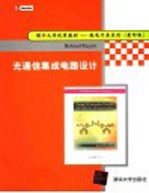
- 作 者:罗扎威(Razavi,B.)著
- 出 版 社:北京:清华大学出版社
- 出版年份:2005
- ISBN:7302107203
- 标注页数:364 页
- PDF页数:378 页
请阅读订购服务说明与试读!
订购服务说明
1、本站所有的书默认都是PDF格式,该格式图书只能阅读和打印,不能再次编辑。
2、除分上下册或者多册的情况下,一般PDF页数一定要大于标注页数才建议下单购买。【本资源378 ≥364页】
图书下载及付费说明
1、所有的电子图书为PDF格式,支持电脑、手机、平板等各类电子设备阅读;可以任意拷贝文件到不同的阅读设备里进行阅读。
2、电子图书在提交订单后一般半小时内处理完成,最晚48小时内处理完成。(非工作日购买会延迟)
3、所有的电子图书都是原书直接扫描方式制作而成。
ContentS 1
1 Introduction to Optical Communications 1
1.1 Brief History 1
1.2 Generic Optical System 2
1.3 Design Challenges 5
1.4 State of the Art 6
2 Basic Concepts 8
2.1 Properties of Random Binary Data 8
2.2 Generation of Random Data 12
2.3 Data Formats 14
2 3 1 NRZ and RZ Data 14
2 3.2 8B/10B Coding 14
2.4 Effect of Bandwidth Limitation on Random Data 16
2.4 1 Effect of Low-Pass Filtering 16
2.4 2 Eye Diagrams 16
2 4.3 Effect of High-Pass Filtering 18
2 5 Effect of Noise on Random Data 21
2 6.1 Phase Noise 24
2.6 Phase Noise and Jitter 24
2 6 2 Jitter 27
2 6 3 Relationship Between Phase Noise and Jitter 28
2.6.4 Jitter Due to Additive Noise 28
2.7 Transmission Lines 30
2 7 1 Ideal Transmission Lines 30
2.7 2 Lossy Transmission Lines 33
3.1 Laser Diodes 36
3 Optical Devices 36
3 1 1 Operation of Lasers 38
3.1.2 Types of Lasers 40
3.1 3 Properties of Lasers 42
3.1.4 Extemal Modulation 45
3.2 Optical Fibers 46
3.2.1 Fiber Loss 47
3.2.2 Fiber Dispersion 48
3 3.1 Responsivity and Efficiency 55
3.3 Photodiodes 55
3.3.2 PIN Diodes 56
3.3 3 Avalanche Photodiodes 57
3.4 Optical Systems 58
4 Transimpedance Amplifiers 62
4.1 General Considerations 62
4.1.1 TIA Performance Parameters 64
4 1 2 SNR Calculations 69
4.1.3 Noise Bandwidth 72
4.2 Open-Loop TIAs 73
4.2.1 Low-Frequency Behavior 73
4.2 2 High-Frequency Behavior 81
4.3 Feedback TIAs 87
4.3 1 First-Order TIA 87
4.3.2 Second-Order TIA 89
4 4 Supply Rejection 97
4.5 Differential TIAs 100
4.6.1 Gain Boosting 103
4.6 High-Performance Technques 103
4.6 2 Capacitive Coupling 105
4.6.3 Feedback TIAs 106
4.6 4 Inductive Peaking 110
4.7 Automatic Gain Control 114
4.8 Case Studies 118
5 Limiting Amplifiers and Output Buffers 123
5.1 General Considerations 123
5.1.1 Performance Parameters 123
5.1 2 Cascaded Gain Stages 125
5.1.3 AM/PM Conversion 129
5.2 Broadband Techniques 131
5.2.1 Inductive Peaking 131
5.2.2 Capacitive Degeneration 133
5.2.3 Cherry-Hooper Amplifier 136
5.2.4 fT Doublers 140
5.3 Output Buffers 142
5 3 1 Differential Signaling 142
5.3.2 Double Termination 146
5.3.3 Predriver Design 149
5.4 Distributed Amplification 152
5.4.1 Monolithic Transmission Lines 152
5.4.2 Distributed Amplifiers 156
5.4.3 Distributed Amplifiers with Lumped Devices 163
6 Oscillator Fundamentals 165
6.1 General Considerations 165
6.2 Ring Oscillators 167
6.3 LC Oscillators 178
6.3.1 Crossed-Coupled Oscillator 181
6.3.2 Colpitts Oscillator 184
6.3.3 One-Port Oscillators 187
6.4 Voltage-Controlled Oscillators 191
6.4.1 Tuning in Ring Oscillators 194
6.4.2 Tuning in LC Oscillators 202
7 LC Oscillators 208
7.1 Monolithic Inductors 208
7.1.1 Loss Mechanisms 210
7.1.2 Inductor Modeling 214
7.1.3 InductorDesign Guidelines 217
7.2 Monolithic Varactors 221
7.3 Basic LC Oscillators 223
7.3.1 Differential Control 226
7.3.2 Design Procedure 228
7.4 Quadrature Oscillators 230
7.4.1 In-Phase Coupling 232
7.4.2 Antiphase Coupling 234
8 Phase-Locked Loops 238
8.1 Simple PLL 238
8.1.1 Phase Detector 238
8.1.2 Basic PLL Topology 239
8.1.3 Dynamics of Simple PLL 248
8.2 Charge-Pump PLLs 254
8.2.1 Problem of Lock Acquisition 255
8.2.2 Phase/Frequency Detector and Charge Pump 256
8.2.3 Basic Charge-Pump PLL 260
8.3.1 PFD/CP Nonidealities 267
8.3 Nonideal Effects in PLLs 267
8.3.2 Jitter in PLLs 271
8.4 Delay-Locked Loops 274
8.5 Applications 276
8.5.1 Frequency Multiplication and Synthesis 277
8.5.2 Skew Reduction 279
8.5.3 Jitter Reduction 280
9.1 General Considerations 282
9 ClockandDataRecovery 282
9.2 Phase Detectors for Random Data 294
9.2.1 Hogge Phase Detector 294
9 2 2 Alexander Phase Detector 298
9.2.3 Half-Rate Phase Detectors 303
9.3 Frequency Detectors for Random Data 307
9.4 CDR Architectures 312
9.4.1 Full-RateReferencelessArchitecture 312
9.4.2 Dual-VCO Architecture 313
9.4.3 Dual-LoopArchitecturewithExternalReference 315
9.5 Jitter in CDR Circuits 316
9.5.1 Jitter Transfer 316
9.5.2 Jitter Generation 321
9.5.3 Jitter Tolerance 323
10 Multiplexers and Laser Drivers 327
10.1 Multiplexers 327
10.1.1 2-to-1 MUX 327
10.1.2 MUX Architectures 332
10.2 Frequency Dividers 335
10.2.1 Flipflop Dividers 335
10.2.2 Miller Divider 343
10.3 Laser and ModulatorDrivers 345
10.3.1 Performance Parameters 345
10.4 Design Principles 349
10.4.1 Power Control 355
Index 357
